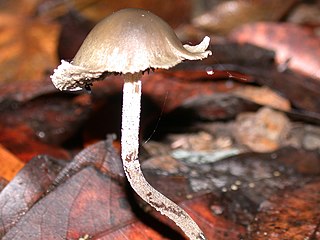
Panaeolus cinctulus, syn. Panaeolus subbalteatus, commonly known as the banded mottlegill, weed Panaeolus or subbs is a very common, widely distributed psilocybin mushroom. According to American naturalist and mycologist David Arora, Panaeolus cinctulus is the most common psilocybin mushroom in California.

Panaeolus tropicalis is a species of psilocybin producing mushroom in the family Bolbitiaceae. It is also known as Copelandia tropicalis.

Panaeolus cyanescens is a mushroom in the Bolbitiaceae family. Panaeolus cyanescens is a common psychoactive mushroom and is similar to Panaeolus tropicalis.

Panaeolus acuminatus, also known as Panaeolus rickenii, is a species of mushroom in the family Bolbitiaceae.

Panaeolus antillarum is a species of mushroom in the family Bolbitiaceae. It is edible but not commonly eaten. It is found from northern North America through Mexico into northern South America.

Panaeolus bisporus, also known as Copelandia bisporus is a rare and widely distributed little brown mushroom that bruises blue and contains the hallucinogen psilocybin.

Panaeolus cambodginiensis is a potent hallucinogenic mushroom that contains psilocybin and psilocin. It was described in 1979 as Copelandia cambodginiensis.

Panaeolus olivaceus is a widely distributed, seldom identified, little brown mushroom that contains the hallucinogen psilocybin; it is often mistaken for Panaeolina foenisecii and is distinguished by its black spore print and darker gill coloration when mature alongside a slightly thicker stem. It is even more easily mistaken for Panaeolus cinctulus or Panaeolus fimicola and can be distinguished from them both by its slightly roughened spores. It is also easily confused with Panaeolina castaneifolia, a species which has spores that are dark brown and significantly more roughened.

Panaeolus fimicola is a widespread but seldom identified "little brown mushroom" which sometimes contains small amounts of the hallucinogen psilocybin. Panaeolis ater is a synonym. The species is also referred to as the "turf mottlegill".

Psilocybe ovoideocystidiata is a psilocybin mushroom in the section Stuntzae, having psilocybin and/or psilocin as main active compounds. It is closely related to P. subaeruginascens from Java, P. septentrionalis from Japan, and P. wayanadensis from India. This mushroom was first documented by Richard V. Gaines in Montgomery County, Pennsylvania in June 2003. Although it is sometimes confused with Psilocybe caerulipes, it can be distinguished by its rhomboid spores, larger stature, earlier fruiting season and membranous annulus.

Panaeolus foenisecii, commonly called the mower's mushroom, haymaker or brown hay mushroom, is a very common and widely distributed little brown mushroom often found on lawns and is not an edible mushroom. In 1963 Tyler and Smith found that this mushroom contains serotonin, 5-HTP and 5-hydroxyindoleacetic acid. In many field guides it is listed as psychoactive; however, the mushroom does not produce any hallucinogenic effects.

Psilocybe caerulipes, commonly known as blue-foot, is a rare psilocybin mushroom of the family Hymenogastraceae, having psilocybin and psilocin as main active compounds. An older synonym is Agaricus caerulipes.

Panaeolus papilionaceus var. parvisporus is a little brown mushroom that grows in horse or cow dung and is in the genus Panaeolus.

Panaeolus papilionaceus, also known as Agaricus calosus, Panaeolus campanulatus, Panaeolus retirugis, and Panaeolus sphinctrinus, and commonly known as Petticoat mottlegill, is a very common and widely distributed little brown mushroom that feeds on dung.

Panaeolus semiovatus var. semiovatus, also known as Panaeolus semiovatus and Anellaria separata, is a medium-sized buff-colored mushroom/toadstool that grows on horse dung, and has black spores. Though nonpoisonous, it is generally regarded as inedible, and a few people experience gastric upset after consumption. Its common names are the shiny mottlegill, or egghead mottlegill.

Inocybe corydalina var. corydalina, commonly known as the greenflush fibrecap, is a member of the genus Inocybe which is widely distributed in temperate forests. It is a small mycorrhizal mushroom which contains a small amount of the hallucinogen psilocybin.

Panaeolina castaneifolia is a rare and widely distributed little brown mushroom.

Mycena mustea is a species of mushroom in the family Mycenaceae. First described as a new species in 2007, the fungus is known only from Kanagawa, Japan, where it grows on dead fallen twigs in lowland forests. The mushroom's dull violet to grayish-violet cap, initially covered with a fine whitish powder, becomes smooth as it matures, and eventually reaches a diameter of up to 10 mm (0.39 in). The stem is slender, up to 90 mm (3.5 in) long, and is covered with stiff white hairs at the base. Underneath the cap are distantly spaced pale brownish gills that are narrowly attached to the stem. Microscopic characteristics of the mushroom include the weakly amyloid spores, the club-shaped cheilocystidia featuring one or more short knob-like protuberances, the absence of pleurocystidia, the diverticulate cap cuticle hyphae, and the absence of clamp connections.

Protostropharia semiglobata, commonly known as the dung roundhead, the halfglobe mushroom, or the hemispheric stropharia, is an agaric fungus of the family Strophariaceae. A common and widespread species with a cosmopolitan distribution, the fungus produces mushrooms on the dung of various wild and domesticated herbivores. The mushrooms have hemispherical straw yellow to buff-tan caps measuring 1–4 cm (0.4–1.6 in), greyish gills that become dark brown in age, and a slender, smooth stem 3–12 cm (1.2–4.7 in) long with a fragile ring.
Panaeolus alcis is a species of agaric fungus in the family Bolbitiaceae. Found in Europe and Canada, it was described as new to science in 1984 by Austrian mycologist Meinhard Michael Moser. The type collection, made in Sweden, was found growing on moose dung. The fungus produces small, brown fruit bodies with bell-shaped to conical caps measuring 0.4–1 cm (0.2–0.4 in) in diameter and 0.3–0.9 cm (0.12–0.35 in) high. Gills are dark gray initially, then develop a black mottling when the spores mature. The gray to brownish stipe is 2–9 cm (0.8–3.5 in) long by 0.5–1.5 mm thick, and pruinose. Spores are smooth, dark brown, and have a pore. They measure 16.3–21 by 8–12 µm when viewed face-on, and 8–10 µm viewed from the side. The fungus has been mostly found fruiting on the droppings of moose, although it has also been recorded on roe deer and reindeer dung.


















